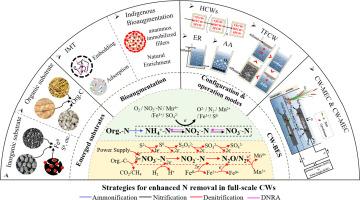人工湿地强化脱氮策略综述:从设计、影响因素到全面应用和挑战
IF 12.4
1区 环境科学与生态学
Q1 ENGINEERING, ENVIRONMENTAL
引用次数: 0
摘要
水体氮的强化脱氮一直是研究热点,过量的氮排放会导致水体富营养化,对水生生态系统造成威胁。人工湿地(CWs)是一种有效的生态技术,已被用于从各种类型的废水中去除深层氮(N)。然而,由于缺乏电子供体和不适宜的溶解氧环境,生物脱氮过程通常受到限制。因此,研究人员开发了许多增强化学武器中氮去除的策略;但这些研究主要集中在实验室规模系统的性能上。对这些策略的去除机制、优缺点、影响因素以及在全尺寸系统中的应用现状进行全面总结仍然不足。本文综述了增强生物膜去除N的不同策略,包括新兴基质的利用、生物增强型生物膜、结构和操作模式的优化以及与生物电化学系统的结合。重点介绍了全面化武的加强机制、主要影响因素、应用和挑战。与传统生化系统相比,新兴基质、生物增强型生化系统和耦合系统可显著提高生化系统的脱氮效率。但是,它们在全面系统中的广泛应用受到几个缺点的阻碍,包括高成本、潜在的二次污染(例如,废水色度过高、pH值高)和长期相对有效性的不确定性。在全尺寸化粪池中最常用的配置和操作模式的优化,由于复杂的操作条件,似乎不能始终有效地增强N的去除。在今后的研究中,对化粪池的强化N策略应特别重视结构设计的合理、强化策略的简单性和经济性、无二次污染。本文章由计算机程序翻译,如有差异,请以英文原文为准。

A review of enhanced strategies for nitrogen removal in constructed wetlands: from design, influencing factors to full-scale applications and challenges
Enhanced N removal from water bodies has always been a research hotspot, as excessive nitrogen discharge will lead to eutrophication and causing a threat to aquatic ecosystems. An effective ecological technology, constructed wetlands (CWs) have been used to undertake the task of deep-level nitrogen (N) removal from various types of wastewaters. However, due to the lack of electron donors and an unsuitable dissolved oxygen environment, the biological N removal process in CWs is usually limited. Therefore, numerous strategies for enhanced N removal in CWs have been developed; But these studies are mainly focus on the performance in lab-scale systems. A comprehensive summary of removal mechanisms, advantages and disadvantages, influencing factors, and the applications status of these strategies in full-scale systems remains insufficient. This paper reviews different strategies applied for the intensifications of N removal in CWs, including the utilization of emerged substrates, bioaugmented CWs, the optimization of configurations and operation modes, and the combination with bioelectrochemical systems. It focuses on the strengthening mechanisms, major influencing factors, applications and challenges in full-scale CWs. Compared to the traditional CWs, nitrogen removal efficiency can be significantly improved in enhanced CWs with emerged substrates, bioaugmented CW and coupled system. But their broad applications in full-scale systems are hindered by several drawbacks, including the high cost, potential secondary pollutions (e.g. excessive effluent chromaticity, high pH levels) and uncertainty in long-term relative effectiveness. The optimization of configurations and operation modes in CWs, which are the most commonly used in full-scale CWs, does not appear to be consistently effective for enhanced N removal because of the complex operation conditions. In the future researches, special emphases of enhanced N strategies in CWs should be given to the reasonable structural design, simplicity and economy of enhanced strategies, and no secondary pollutions.
求助全文
通过发布文献求助,成功后即可免费获取论文全文。
去求助
来源期刊

Water Research
环境科学-工程:环境
CiteScore
20.80
自引率
9.40%
发文量
1307
审稿时长
38 days
期刊介绍:
Water Research, along with its open access companion journal Water Research X, serves as a platform for publishing original research papers covering various aspects of the science and technology related to the anthropogenic water cycle, water quality, and its management worldwide. The audience targeted by the journal comprises biologists, chemical engineers, chemists, civil engineers, environmental engineers, limnologists, and microbiologists. The scope of the journal include:
•Treatment processes for water and wastewaters (municipal, agricultural, industrial, and on-site treatment), including resource recovery and residuals management;
•Urban hydrology including sewer systems, stormwater management, and green infrastructure;
•Drinking water treatment and distribution;
•Potable and non-potable water reuse;
•Sanitation, public health, and risk assessment;
•Anaerobic digestion, solid and hazardous waste management, including source characterization and the effects and control of leachates and gaseous emissions;
•Contaminants (chemical, microbial, anthropogenic particles such as nanoparticles or microplastics) and related water quality sensing, monitoring, fate, and assessment;
•Anthropogenic impacts on inland, tidal, coastal and urban waters, focusing on surface and ground waters, and point and non-point sources of pollution;
•Environmental restoration, linked to surface water, groundwater and groundwater remediation;
•Analysis of the interfaces between sediments and water, and between water and atmosphere, focusing specifically on anthropogenic impacts;
•Mathematical modelling, systems analysis, machine learning, and beneficial use of big data related to the anthropogenic water cycle;
•Socio-economic, policy, and regulations studies.
 求助内容:
求助内容: 应助结果提醒方式:
应助结果提醒方式:


